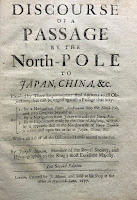 The possibility of an efficient trade route from Europe to East Asia was an idea that gripped the imaginations of European explorers for centuries after Columbus's discovery of the American continent. In 1697, a member of the Royal Society and hydrographer to Charles II, published the second edition of a popular self-authored pamphlet that recommended a new approach to this puzzle.
The possibility of an efficient trade route from Europe to East Asia was an idea that gripped the imaginations of European explorers for centuries after Columbus's discovery of the American continent. In 1697, a member of the Royal Society and hydrographer to Charles II, published the second edition of a popular self-authored pamphlet that recommended a new approach to this puzzle. In the aptly named "A Brief Discourse of a Passage by the North-Pole to Japan, China, Etc.," Moxon spends six pages to explain why he believes that pursuing a course through the Arctic is the most likely strategy to succeed. Moxon says that he has been "credibly informed by a steersman of a Dutch Greenland ship" that the North Pole is actually a warm and open sea. Based on this expert advice, Moxon goes on to say that he is convinced that the ice encountered by ships only appeared near land masses; if that narrow band of Arctic ice could be traversed, then it would be free and warm sailing across the top of the world and down to Japan.
In the aptly named "A Brief Discourse of a Passage by the North-Pole to Japan, China, Etc.," Moxon spends six pages to explain why he believes that pursuing a course through the Arctic is the most likely strategy to succeed. Moxon says that he has been "credibly informed by a steersman of a Dutch Greenland ship" that the North Pole is actually a warm and open sea. Based on this expert advice, Moxon goes on to say that he is convinced that the ice encountered by ships only appeared near land masses; if that narrow band of Arctic ice could be traversed, then it would be free and warm sailing across the top of the world and down to Japan.
Moxon's hypothesis was eagerly embraced by other reputable Northwest Passage enthusiasts, who further developed his idea to the point that in 1776, Captain Cook embarked on his third voyage to the Pacific with the goal of finding a way through the Arctic to the Atlantic. As you might already know, one of Cook's crewman on that trip was John Ledyard, a non-graduate of the class of 1776.
To skim Moxon's pamphlet and look at his map which shows what was known of the Arctic Circle at the time, come to Rauner and ask for Stefansson G640 .M69 1697.